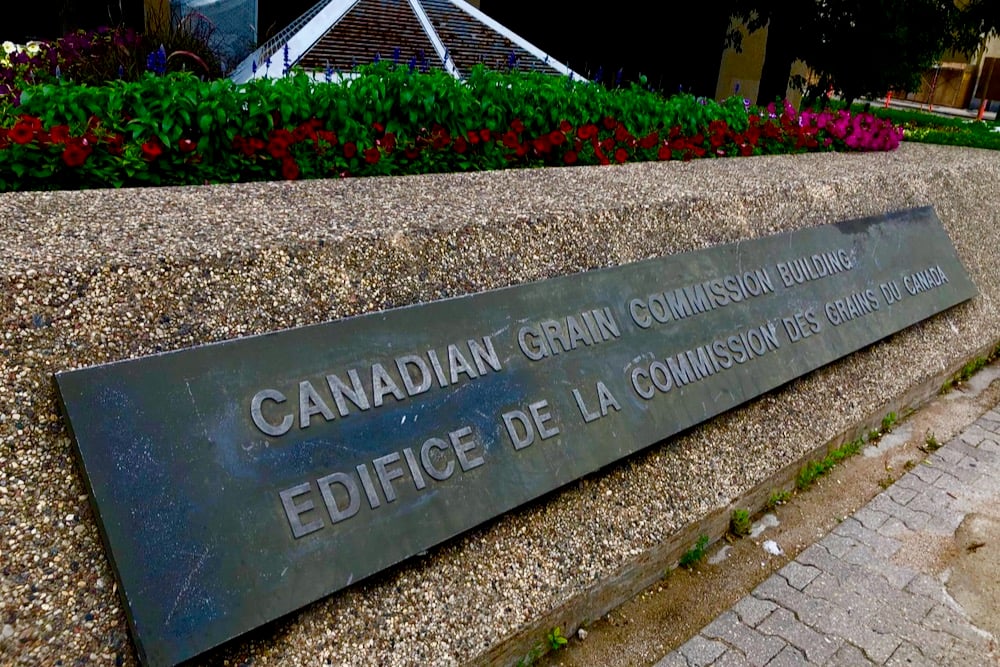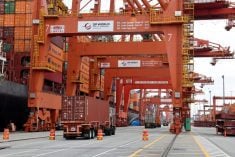ST. MALO, Man. — Patches of stunted, yellowed and thin soybean crops aren’t hard to find south and southeast of Winnipeg.
Manitoba’s new soybean growers have been learning to abhor these patches of jaundiced crop, which are caused by iron chlorosis.
But how can a farmer avoid this problem, which is caused by saturated soil stopping soybean plants from acidifying the surrounding soil and making iron soluble.
“This is a problem that can be short-lived,” Manitoba Agriculture land management specialist Marla Riekman said during the Manitoba Pulse and Soybean Growers field day at the Carman research farm.
Read Also

Canadian Grain Commission to use surplus to avoid fee increases
The Canadian Grain Commission will continue to use its surplus to cover budget shortfalls and avoid potential fee increases until 2028, the federal agency announced Monday, Oct. 27.
“The plants will (often) pull through it.”
Riekman said farmers should look for varieties that are tolerant of iron deficiency because some varieties are much better able to “grow through it a little bit faster.”
Indeed, two experienced Manitoba soybean growers who were on the July 21-25 CWB crop tour didn’t think that the fields they checked south of Winnipeg were necessarily severely damaged, even though they had substantial areas of yellowing and thinness.
“This crop can rebound from this if it gets a chance,” said one of the farmers as the tour walked through the blighted field.
Manitoba soybean crops seen on the tour are generally in excellent shape and look to provide good, three-bean pods, with iron chlorosis the only significant field problem spotted.
Manitoba soil, especially in the Red River Valley with its heavy clay, can suffer heavy saturation from either rain or river flooding. The area is also the home to much of Manitoba’s soybean production.
That combination has allowed iron chlorosis to leap out of nowhere in wet years, often alarming new soybean growers who haven’t dealt with it previously.
Riekman said there are no easy rescue treatments for iron chlorosis, which leaves farmers in a pickle if it’s severe.
Strawberry growers sometimes apply a foliar iron treatment, but they have to do it weekly because iron doesn’t travel within the plant.
“They’re doing OK, but they’re also making some good money,” she said.
“We can’t necessarily afford to do that in soybeans.”
An in-furrow treatment exists in the United States, but it is not legally available in Canada, even for researchers, Riekman said. However, it’s not a rescue treatment because it needs to go in during seeding.
It’s not cheap at $40 an acre, but Riekman said a farmer could use it only on chronically iron-chlorosed patches. They are easy to identify because “the beautiful thing about (iron chlorosis) is that you have an ability to take a picture of it and you’ll know exactly where it’s going to show up again and again and again.… You know you’re going to have the same problem come back whenever you have soybeans and when you have too much wetness.”
The farmers and analysts on the tour thought most of the affected crops they saw could leave iron chlorosis behind without too much yield loss because of the recent drier weather in the soybean-growing areas.
However, it all depends on the next few weeks’ weather, and no one can predict that.
ed.white@producer.com















